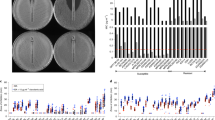Abstract.
Staphylococci have two mechanisms for resistance to β-lactam antibiotics. One is the production of β-lactamases, enzymes that hydrolytically destroy β-lactams. The other is the expression of penicillin-binding protein 2a (PBP 2a), which is not susceptible to inhibition by β-lactam antibiotics. Strains of S. aureus exhibiting either β-lactamase or PBP 2a-directed resistance (or both) have established a considerable ecological niche among human pathogens. The emergence and subsequent spread of bacterial strains designated as methicillin-resistant S. aureus (MRSA), from the 1960s to the present, has created clinical difficulties for nosocomial treatment on a global scale. The recent variants of MRSA that are resistant to glycopeptide antibiotics (such as vancomycin) have ushered in a new and disconcerting chapter in the evolution of this organism.
Similar content being viewed by others
Author information
Authors and Affiliations
Corresponding author
Additional information
Received 2 April 2005; received after revision 15 July 2005; accepted 25 July 2005
Rights and permissions
About this article
Cite this article
Fuda, C.C.S., Fisher, J.F. & Mobashery, S. β-Lactam resistance in Staphylococcus aureus: the adaptive resistance of a plastic genome. Cell. Mol. Life Sci. 62, 2617 (2005). https://doi.org/10.1007/s00018-005-5148-6
Published:
DOI: https://doi.org/10.1007/s00018-005-5148-6




